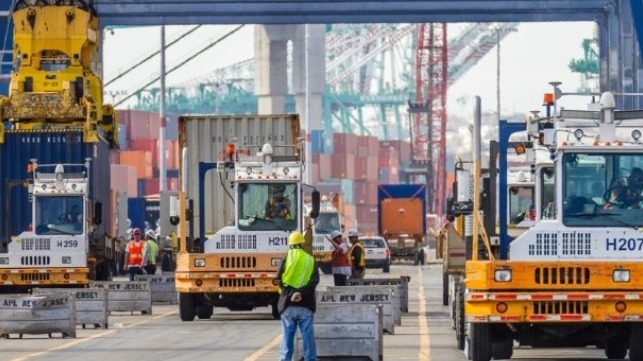Los Angeles Seeks to Reduce Emissions from Cargo Handling Operations

The Los Angeles city government is seeking to expand on the current initiatives to reduce emissions for the cargo handling operations at the ports in San Pedro Bay.
Mayor Eric Garcetti of Los Angeles announced a new Request for Information (RFI) to solicit proposals to expand the use of zero-emission technology at the Port of Los Angeles. The RFI, which seeks submissions by the beginning of January 2021, supports the goal to transition all drayage trucks serving the San Pedro Bay port complex to zero-emission by 2035.
“Our RFI sends a strong signal,” said Mayor Garcetti. “Los Angeles is a laboratory for new technology, a pioneering destination for sustainability, and a place where we deploy the power of innovation to strengthen lives, secure livelihoods, and preserve public health.” His goal is to lead a transition toward a greener economy.
The RFI invites the private sector to provide input to the Port of Los Angeles as it explores strategies to accelerate the development and adoption of zero-emission trucks. As part of its Clean Air Action Plan, Los Angeles pledged to see 100 percent zero-emission trucks coming into and out of the port in the next 15 years.
“The Port is currently engaged in 16 different zero-emission demonstration projects designed to bring feasible technology to the marketplace,” said Port of Los Angeles Executive Director Gene Seroka. “Conversion of the port drayage fleet to zero-emission technology involves tremendous financial investment and will take the collaboration and commitment of many stakeholders - both public and private - to create a viable market for zero-emissions drayage technology. This RFI is designed to recruit the best ideas available to help us serve as a catalyst and make a meaningful impact on climate change."
Submissions should address approaches to maximize the use of public and private funding sources; describe new asset management structures that can accommodate the San Pedro Bay Ports’ scale; incorporate proposals for charging and fueling infrastructure; propose clear maintenance and procurement methods, and layout a public-private partnership model to achieve the zero-emission transition.
“Los Angeles is showing how cities can take the lead in accelerating the shift away from polluting heavy-duty trucks to zero-emission technologies,” said CARB Chair Mary D. Nichols. “This will help clean up the air in port-adjacent communities, and provide major financial assistance to businesses as they transition to one-hundred percent zero-emission trucks in our ports.”
In October, a container terminal in the neighboring Port of Long Beach launched a year-long pilot project to test the readiness of new, zero-emissions cargo-handling tractors to handle the workload at a busy seaport. A container shipping terminal at the Port of Long Beach is now using It is part of the port and state of California’s long-term initiative to lower emission from the port and industrial operations across the state. The terminal operated by International Transportation Service is demonstrating seven BYD battery-electric yard tractors for one year.
In the Port of Los Angeles, at the Everport Container Terminal, they are also operating two battery-electric top handlers in a separate demonstration project. They each run on a one-megawatt battery designed to operate for up to 18 hours between charges. Each top handler has a data logger for tracking hours of operation, charging frequency, energy usage, and other performance indicators. Additionally, drivers and mechanics are providing input on the maneuverability, noise level, and safety of the equipment.
The Port of Los Angeles is also testing ultra-low NOx renewable natural gas equipment and fully battery-electric fuel cell heavy-duty trucks; battery-electric forklifts, yard tractors, and rubber-tired gantry cranes; and emissions control equipment on large ships and harbor craft.
Eliminating tailpipe emissions from cargo-handling equipment is essential to achieving the port’s goal of reducing greenhouse gases 40 percent below 1990 levels by 2030 and 80 percent below 1990 levels by 2050.
